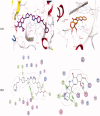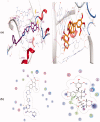New 1,2,3-triazole linked ciprofloxacin-chalcones induce DNA damage by inhibiting human topoisomerase I& II and tubulin polymerization
- PMID: 35548854
- PMCID: PMC9116245
- DOI: 10.1080/14756366.2022.2072308
New 1,2,3-triazole linked ciprofloxacin-chalcones induce DNA damage by inhibiting human topoisomerase I& II and tubulin polymerization
Abstract
A series of novel 1,2,3-triazole-linked ciprofloxacin-chalcones 4a-j were synthesised as potential anticancer agents. Hybrids 4a-j exhibited remarkable anti-proliferative activity against colon cancer cells. Compounds 4a-j displayed IC50s ranged from 2.53-8.67 µM, 8.67-62.47 µM, and 4.19-24.37 µM for HCT116, HT29, and Caco-2 cells; respectively, whereas the doxorubicin, showed IC50 values of 1.22, 0.88, and 4.15 µM. Compounds 4a, 4b, 4e, 4i, and 4j were the most potent against HCT116 with IC50 values of 3.57, 4.81, 4.32, 4.87, and 2.53 µM, respectively, compared to doxorubicin (IC50 = 1.22 µM). Also, hybrids 4a, 4b, 4e, 4i, and 4j exhibited remarkable inhibitory activities against topoisomerase I, II, and tubulin polymerisation. They increased the protein expression level of γH2AX, indicating DNA damage, and arrested HCT116 in G2/M phase, possibly through the ATR/CHK1/Cdc25C pathway. Thus, the novel ciprofloxacin hybrids could be exploited as potential leads for further investigation as novel anticancer medicines to fight colorectal carcinoma.
Keywords: Click synthesis; DNA damage; HCT116 cells; chalcone; ciprofloxacin; cytotoxicity; topoisomerase I and II inhibitors; tubulin polymerisation inhibition.
Conflict of interest statement
No potential conflict of interest was reported by the author(s).
Figures















Similar articles
-
Novel urea linked ciprofloxacin-chalcone hybrids having antiproliferative topoisomerases I/II inhibitory activities and caspases-mediated apoptosis.Bioorg Chem. 2021 Jan;106:104422. doi: 10.1016/j.bioorg.2020.104422. Epub 2020 Oct 22. Bioorg Chem. 2021. PMID: 33248713
-
Novel ciprofloxacin hybrids using biology oriented drug synthesis (BIODS) approach: Anticancer activity, effects on cell cycle profile, caspase-3 mediated apoptosis, topoisomerase II inhibition, and antibacterial activity.Eur J Med Chem. 2018 Apr 25;150:403-418. doi: 10.1016/j.ejmech.2018.03.026. Epub 2018 Mar 9. Eur J Med Chem. 2018. PMID: 29547830
-
Design, synthesis, and molecular docking of novel pyrazole-chalcone analogs of lonazolac as 5-LOX, iNOS and tubulin polymerization inhibitors with potential anticancer and anti-inflammatory activities.Bioorg Chem. 2022 Dec;129:106171. doi: 10.1016/j.bioorg.2022.106171. Epub 2022 Sep 22. Bioorg Chem. 2022. PMID: 36166898
-
Anticancer Activity of Natural and Synthetic Chalcones.Int J Mol Sci. 2021 Oct 20;22(21):11306. doi: 10.3390/ijms222111306. Int J Mol Sci. 2021. PMID: 34768736 Free PMC article. Review.
-
Recent Trends in the Synthesis and Bioactivity of Coumarin, Coumarin-Chalcone, and Coumarin-Triazole Molecular Hybrids.Molecules. 2024 Feb 27;29(5):1026. doi: 10.3390/molecules29051026. Molecules. 2024. PMID: 38474540 Free PMC article. Review.
Cited by
-
A ciprofloxacin derivative with four mechanisms of action overcomes paclitaxel resistance in p53-mutant and MDR1 gene-expressing type II human endometrial cancer.Biomaterials. 2023 May;296:122093. doi: 10.1016/j.biomaterials.2023.122093. Epub 2023 Mar 17. Biomaterials. 2023. PMID: 36965280 Free PMC article.
-
Synthesis of New Thiazole-Privileged Chalcones as Tubulin Polymerization Inhibitors with Potential Anticancer Activities.Pharmaceuticals (Basel). 2024 Aug 31;17(9):1154. doi: 10.3390/ph17091154. Pharmaceuticals (Basel). 2024. PMID: 39338317 Free PMC article.
-
Indole Derivatives: A Versatile Scaffold in Modern Drug Discovery-An Updated Review on Their Multifaceted Therapeutic Applications (2020-2024).Molecules. 2024 Oct 9;29(19):4770. doi: 10.3390/molecules29194770. Molecules. 2024. PMID: 39407697 Free PMC article. Review.
-
Synthesis and biological evaluation of ciprofloxacin - 1,2,3-triazole hybrids as antitumor, antibacterial, and antioxidant agents.Heliyon. 2023 Nov 28;9(12):e22592. doi: 10.1016/j.heliyon.2023.e22592. eCollection 2023 Dec. Heliyon. 2023. PMID: 38125538 Free PMC article.
-
Cationic nanoparticles enhance T cell tumor infiltration and antitumor immune responses to a melanoma vaccine.Sci Adv. 2022 Jul 22;8(29):eabk3150. doi: 10.1126/sciadv.abk3150. Epub 2022 Jul 20. Sci Adv. 2022. PMID: 35857851 Free PMC article.
References
-
- Abdel-Aal MAA, Abdel-Aziz SA, Shaykoon MSA, Abuo-Rahma GE-DA.. Towards anticancer fluoroquinolones: a review article. Arch Pharm 2019;352:e1800376. - PubMed
-
- Kaushik CP, Sangwan J, Luxmi R, et al. . Design, synthesis, anticancer and antioxidant activities of amide linked 1,4-disubstituted 1,2,3-triazoles. J. Mol. Struct 2021;1226:129255.
-
- Chekkara R, Gorla VR, Susithra E, et al. . Design, synthesis and anticancer evaluation of 2-amino pyrimidine linked 7-azaindzole derivatives. Chem. Data Collect 2020;29:100513.
-
- El-Damasy AK, Haque MM, Park JW, et al. . 2-Anilinoquinoline based arylamides as broad spectrum anticancer agents with B-RAFV600E/C-RAF kinase inhibitory effects: design, synthesis, in vitro cell-based and oncogenic kinase assessments. Eur J Med Chem 2020;208:112756. - PubMed
-
- Baglini E, Salerno S, Barresi E, et al. . Multiple topoisomerase I (TopoI), topoisomerase II (TopoII) and Tyrosyl-DNA phosphodiesterase (TDP) inhibitors in the development of anticancer drugs. Eur J Pharm Sci 2021;156:105594. - PubMed
MeSH terms
Substances
Grants and funding
LinkOut - more resources
Full Text Sources
Other Literature Sources
Research Materials
Miscellaneous
